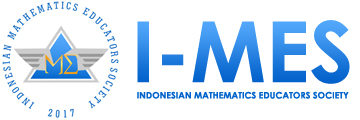Analysis of Student Computational Thinking in Solving Social Statistics Problems
Analysis of Student Computational Thinking in Solving Social Statistics Problems
DOI:
https://doi.org/10.35706/sjme.v5i1.4376Abstrak
This study aims to see students' computational thinking in solving social statistics questions and to find out why students experience their mistakes. This type of research uses a descriptive qualitative approach. The subjects used in this study were Governmental Science students taking the Social Statistics course. Data collection techniques were carried out by observation and tests. The instruments used in this study were the observation sheet and the test question sheet. The analysis is carried out by reducing the data first, then presenting the data, and ending by concluding the results of the computational thinking indicator. The results showed that all aspects of computational thinking have been carried out by students, starting from Decomposition, Pattern Recognition, Abstraction, and Algorithm design. Students get the highest percentage, namely algorithm design with 84% and the lowest on decomposition with 65.5%. The cause of errors, in general, is because students are not used to completing in a structured manner. Students are accustomed to solving problems by directly substituting values into the formula without first writing down what is known and looking for what is needed in the questions first.
Unduhan
Referensi
Città, G., Gentile, M., Allegra, M., Arrigo, M., Conti, D., Ottaviano, S., Reale, F., & Sciortino, M. (2019). The effects of mental rotation on computational thinking. Computers and Education, 141(May). https://doi.org/10.1016/j.compedu.2019.103613
Durak, H. Y., & Saritepeci, M. (2018). Analysis of the relation between computational thinking skills and various variables with the structural equation model. Computers and Education, 116. https://doi.org/10.1016/j.compedu.2017.09.004
Gazali, R. Y. (2016). Pembelajaran Matematika Yang Bermakna. Math Didactic, 2(3), 181–190. https://doi.org/10.33654/math.v2i3.47
Kong, S. C., & Li, P. (2016). A case study illustrating coding for computational thinking development. ICCE 2016 - 24th International Conference on Computers in Education: Think Global Act Local - Main Conference Proceedings.
Kusumawardani, D. R., Wardono, & Kartono. (2018). Pentingnya Penalaran Matematika dalam Meningkatkan Kemampuan Literasi Matematika. Prisma, 1(1), 588–595.
Nafi’an, M. I. (2011). P – 53 Kemampuan Siswa Dalam Menyelesaikan Soal Cerita. Seminar Nasional Matematika Dan Pendidikan Matematika Jurusan Pendidikan Matematika FMIPA UNY, 978–979.
Nam, C.-M. (2011). An Analysis of Teaching and Learning Activities in Elementary Mathematics Based on Computational Thinking. Journal of Educational Research Institute, 13(2). https://doi.org/10.15564/jeri.2011.11.13.2.325
Olabe, J. C., Basogain, X., & Olabe, M. Á. (2019). Modern education with a computational model of the mind. ACM International Conference Proceeding Series. https://doi.org/10.1145/3371647.3371666
Rahman, F., & Dkk. (2011). Impact of Discussion Method on Students Performance. International Journal of Business and Social Science, 2(7), 84–94.
Swaid, S. I. (2015). Bringing Computational Thinking to STEM Education. Procedia Manufacturing, 3(Ahfe), 3657–3662. https://doi.org/10.1016/j.promfg.2015.07.761
Syarifah, L. L. (2017). Analisis Kemampuan Pemahaman Matematis Pada Mata Kuliah Pembelajaran Matematika Sma Ii. Jurnal Penelitian Dan Pembelajaran Matematika, 10(2), 57–71. https://doi.org/10.30870/jppm.v10i2.2031
Ulpah, M. (2009). Belajar Statistika: Mengapa dan Bagaimana? INSANIA : Jurnal Pemikiran Alternatif Kependidikan, 14(3), 325–435. https://doi.org/10.24090/insania.v14i3.354
##submission.downloads##
Diterbitkan
Versi
- 2021-03-19 (2)
- 2021-01-29 (1)
Cara Mengutip
Terbitan
Bagian
Lisensi

Artikel ini berlisensiCreative Commons Attribution-ShareAlike 4.0 International License.
Hak cipta dilindingi undang-undang berdasarkan Undang-undang Nomor 28 Tahun 2014 tentang Hak Cipta. Dilarang memperbanyak isi jurnal ini, baik sebagian maupun seluruhnya dalam bentuk apapun tanpa izin tertulis dari SJME (Supremum Journal of Mathematics Education) sebagai pemegang Hak Cipta terhadap seluruh isi dari jurnal tersebut.
Penulis yang menerbitkan jurnal ini setuju dengan persyaratan berikut:
- Penulis mempertahankan hak cipta dan memberikan hak jurnal tentang publikasi pertama dengan karya yang secara bersamaan dilisensikan di bawah Lisensi Atribusi Creative Commons yang memungkinkan orang lain membagikan karya tersebut dengan pengakuan dari karya penulis dan publikasi awal dalam jurnal ini.
- Penulis dapat memasukkan pengaturan kontrak tambahan yang terpisah untuk distribusi non-eksklusif dari versi terbitan jurnal tersebut (misalnya, kirimkan ke repositori institusional atau publikasikan dalam sebuah buku), dengan sebuah pengakuan atas publikasi awalnya di Jurnal ini.
- Penulis diizinkan dan didorong untuk memposting pekerjaan mereka secara online (misalnya di repositori institusional atau di situs web mereka) sebelum dan selama proses penyampaian, karena dapat menyebabkan pertukaran yang produktif, serta kutipan karya yang diterbitkan sebelumnya dan yang lebih lama.











